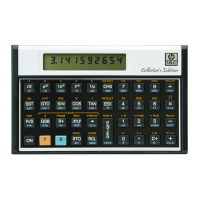Section 11: Calculating With Complex Numbers 131
One-Number Functions
The following functions operate on both the real and imaginary parts of
the number in the X-register, and place the real and imaginary parts of
the answer back into those registers.
¤ x N o ⁄ @ ' a : ;
All trigonometric and hyperbolic functions and their inverses also belong
to this group.
*
The a function gives the magnitude of the number in the X-registers
(the square root of the sum of the squares of the real and imaginary
parts); the imaginary part of the magnitude is zero.
: converts to polar form and ; converts to rectangular form,
as described later in this section (page 133).
For the trigonometric functions, the calculator considers numbers in the
real and imaginary X-registers to be expressed in radians—regardless of
the current trigonometric mode. To calculate trigonometric functions for
values given in degrees, use r to convert those values to radians
before executing the trigonometric function.
Two-Number Functions
The following functions operate on both the real and imaginary parts of
the numbers in the X- and Y-registers, and place the real and imaginary
parts of the answer into the X-registers. Both stacks drop, just as the
ordinary stack drops after a two-number function not in Complex mode.
+ - * ÷ y
Stack Manipulation Functions
When the calculator is in Complex mode, the following functions
simultaneously manipulate both the real and imaginary stacks in the
same way as they manipulate the ordinary stack when the calculator is
not in Complex mode. The ® function, for instance, will exchange both
the real and imaginary parts of the numbers in the X- and Y-registers.
® ) ( v K
*
Refer to the HP 15c Advanced Functions Handbook for definitions of complex
trigonometric functions and further information about doing calculations in Complex
mode.

